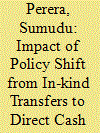|
|
|
Sort Order |
|
|
|
Items / Page
|
|
|
|
|
|
|
| Srl | Item |
| 1 |
ID:
178436


|
|
|
|
|
| Summary/Abstract |
Trade credit transactions are quite common for businesses. The article carries out the trade credit analysis for an emerging economy, namely Indian corporate sector employing rich information dataset covering multiple industries such as manufacturing, services, construction and others, since the period of financial crisis including both firm specific and macro-economic factors. The annual dataset spans 13 years from 2006 to 2018 covering the crisis period. Applying dynamic panel framework, it is found that the inventory management and macro indicators are significant in determining trade credit for Indian firms. While trade payable is chiefly driven by raw material inventory, firms having reasonable stock of raw or finished goods inventory are less likely to offer trade credit. Large-sized firms are found to be both leading consumers and suppliers of the trade credit. The pecking order theory is clearly validated with net profits being preferred over the trade credit that is a more expensive source of finance. Credit from formal financial sources is found to act as a substitute to trade credit borrowing.
|
|
|
|
|
|
|
|
|
|
|
|
|
|
|
|
| 2 |
ID:
178435


|
|
|
|
|
| Summary/Abstract |
The number of people aged more than 60 in Bangladesh is projected to constitute 20% of total population by 2051. The demographic momentum makes it necessary to pursue policies that guarantee a secured life for the country’s senior citizens. Currently, more than 40% of old age population (more than 65 years) in Bangladesh do not receive any type of pension or social security benefits. In this backdrop, introduction of a universal pension scheme (UPS) is an idea that should merit serious consideration. The idea of a UPS is also aligned with several Sustainable Development Goals (SDG) targets. Based on the International Labour Organization multi-pillar pension model, the article deals with required financing under different scenarios of introducing UPS in Bangladesh. The study estimates that for introducing a non-contributory UPS in Bangladesh, it would require an additional average allocation equivalent to 0.1%–0.5% of gross domestic product per annum between now and 2040. The article also estimates financing needs considering two options for the contributory UPS. The article concludes that UPS in Bangladesh can be launched on a limited scale which then could be expanded in scope and coverage in a gradual and phased manner. The article also underscores that introduction of UPS will create opportunities to rationalize the existing safety net programmes that will release funds for underwriting the UPS.
|
|
|
|
|
|
|
|
|
|
|
|
|
|
|
|
| 3 |
ID:
178434


|
|
|
|
|
| Summary/Abstract |
In 2016, the Sri Lankan government introduced a policy change related to fertilizer subsidy by converting the in-kind transfer into a direct cash transfer. This research article analyses the consequences of this policy change on the paddy production from economics perspective. The analysis uses national-level data from 1961 to 2013 and farm-level data collected in 2016. Macro-level findings manifest that the use of fertilizer significantly increases the paddy production in Sri Lanka. It was also identified that the cash amount granted under the direct cash transfer policy is not equivalent to the in-kind transfer programme. As a result, paddy production is expected to decline under the direct cash transfer programme when compared to the material subsidy scheme. However, this is against the preference of economists on direct cash transfers over in-kind transfers. The findings reveal that direct cash transfers increase the paddy production under two conditions: (a) when rational farmers effectively utilize the cash grants to optimize their production inputs; and (b) an equivalent amount of in-kind transfer is provided as direct cash transfer. Hence, direct cash transfers are not always better than in-kind transfers; it is better when in-kind transfer is compensated with an equivalent amount of cash transfer.
|
|
|
|
|
|
|
|
|
|
|
|
|
|
|
|
| 4 |
ID:
178432


|
|
|
|
|
| Summary/Abstract |
The conventional mandates of the central banks on meeting stability objectives and maintaining a growth-maximizing inflation rate have come under some criticism since the global financial crises. Maintaining adequate foreign reserves is seen as a viable solution to foreign exchange liquidity needs during crisis periods. Since the end of 2011, many Asian economies, including China and Japan, led from the forefront in central bank-led reserves build-up. However, reserves build-up remains challenging and sensitive for small open economies. Such policies help create ‘risk-neutral’ buffers for monetary and fiscal authorities to absorb transitory current account shocks and foreign exchange stress to smoothen the balance of payments. This study is motivated by the importance of identifying the inflation–foreign reserves nexus that may affect inflation in a manner counterproductive to the central bank mandate of maintaining price stability. It probes the debate of the sustainability of reserves build-up in the long and the short term. The outcome of the study poses several vital questions for fiscal and monetary policymakers concerning their respective mandates. The reserves–inflation nexus and its magnitude is determined using monthly data spanning two decades, through engaging an autoregressive distributed lag (ARDL) model and relevant bounds-testing techniques proposed by Pesaran et al. The vector autoregression (VAR), error correction and Johansen cointegration methods supplement the robustness checks. Exchange rate is introduced to enrich the discussion on the reserves–inflation nexus and shows a cointegration relationship in the long run. The study provides an insight into the influence of exchange rate on reserves and inflation. The variance decomposition shows the presence of a lukewarm response from foreign reserves and exchange rate on inflation. Policymakers concerned with inflationary expectations in the medium-to-long term need to consider these signals, as reserves build-up is one of the important policy-driven objectives for a number of economies.
|
|
|
|
|
|
|
|
|
|
|
|
|
|
|
|
| 5 |
ID:
178431


|
|
|
|
|
| Summary/Abstract |
We model the evolution and determinants of shares of agriculture, manufacturing and services to gross domestic product for four South Asian countries (Bangladesh, India, Sri Lanka and Pakistan) for 41 years (1974–2018) to understand their structural transformation pattern. Determinants of shares were classified into three broad categories: ‘country fundamentals’, ‘policy’ and ‘decadal dummies’. This is the first article to investigate the empirical regularities of the structural transformation pattern and their determinants for this region. The generalized least squares estimation technique for panel data was applied. We find mixed evidence in support of structural transformation. With the increase in per capita income, the share of agriculture decreases and that of services increases, partially supporting the Kuznets hypothesis; however, the share of manufacturing sector shows a more tepid rise and even decreases in some model specifications. Thus, the Kuznets model of structural transformation is supported to some extent, but not strongly for these countries.
|
|
|
|
|
|
|
|
|
|
|
|
|
|
|
|
| 6 |
ID:
178433


|
|
|
|
|
| Summary/Abstract |
This study empirically investigates the effect of terrorism and other push and pull factors on the skilled labour out-migration in Pakistan over the time period 1973–2015. The empirical findings based on fully modified ordinary least squares (FM-OLS) technique suggest that the waves of terrorism have not significantly driven the out-migration of skilled labour from Pakistan. Relatively, traditional push factors including inflation, unemployment and rising capital share in gross domestic product (GDP) have remained the major factors behind brain drain from Pakistan. Comparatively, the per capita economic growth, poverty and host and origin country’s emigration policies have curtailed the skilled out-migration. The findings suggest improving socio-economic conditions, increasing GDP per capita and decreasing unemployment and inflation in order to control the out-migration of skilled workers from Pakistan. Besides, the domestic labour market is required to boost the absorption capacity of highly educated and qualified workers in the country by making them more compatible to the existing stock of capital to restrict the brain drain.
|
|
|
|
|
|
|
|
|
|
|
|
|
|
|
|
|
|
|
|
|